Background radiation is a measure of the level of ionizing radiation present in the environment at a particular location which is not due to deliberate introduction of radiation sources.

Ernest Rutherford, 1st Baron Rutherford of Nelson, was a New Zealand–born British physicist who came to be known as the father of nuclear physics. Encyclopædia Britannica considers him to be the greatest experimentalist since Michael Faraday (1791–1867).
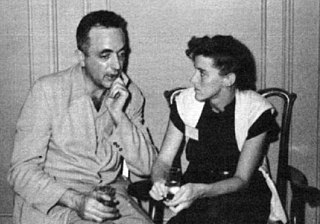
Fritz Reuter Leiber Jr. was an American writer of fantasy, horror, and science fiction. He was also a poet, actor in theater and films, playwright and chess expert. With writers such as Robert E. Howard and Michael Moorcock, Leiber can be regarded as one of the fathers of sword and sorcery fantasy, having coined the term.
"The Green Hills of Earth" is a science fiction short story by American writer Robert A. Heinlein. One of his Future History stories, the short story originally appeared in The Saturday Evening Post, and it was collected in The Green Hills of Earth. Heinlein selected the story for inclusion in the 1949 anthology My Best Science Fiction Story. "The Green Hills of Earth" is also the title of a song mentioned in several of Heinlein's novels.

Irène Joliot-Curie was a French chemist, physicist, and a politician of Polish ancestry, the daughter of Marie Curie and Pierre Curie, and the wife of Frédéric Joliot-Curie. Jointly with her husband, Joliot-Curie was awarded the Nobel Prize in Chemistry in 1935 for their discovery of artificial radioactivity. This made the Curies the family with the most Nobel laureates to date. She was also one of the first three women to be a member of a French government, becoming undersecretary for Scientific Research under the Popular Front in 1936. Both children of the Joliot-Curies, Hélène and Pierre, are also prominent scientists.

The Big Sleep (1939) is a hardboiled crime novel by Raymond Chandler, the first to feature the detective Philip Marlowe. It has been adapted for film twice, in 1946 and again in 1978. The story is set in Los Angeles.
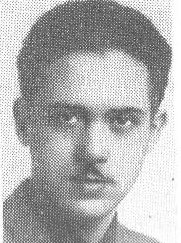
Henry Kuttner was an American author of science fiction, fantasy and horror.
"Robbie" is a science fiction short story by American writer Isaac Asimov. It was his first robot story and writing commenced on June 10, 1939. It was first published in the September 1940 issue Super Science Stories magazine as "Strange Playfellow", a title that was chosen by editor Frederik Pohl and described as "distasteful" by Asimov. A revised version of Robbie was reprinted under Asimov's original title in the collections I, Robot (1950), The Complete Robot (1982), and Robot Visions (1990). "Robbie" was the fourteenth story written by Asimov, and the ninth to be published. The story is also part of Asimov's Robot series, and was the first of Asimov's positronic robot stories to see publication.
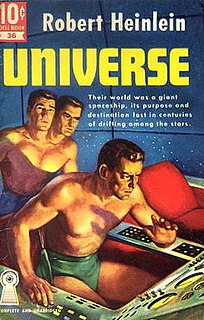
X Minus One is an American half-hour science fiction radio drama series that broadcast from April 24, 1955 to January 9, 1958 in various timeslots on NBC. Known for high production values in adapting stories from the leading American authors of the era, X Minus One has been described as one of the finest offerings of American radio drama and one of the best science fiction series in any medium.

The Big Time (1958) is a short science fiction novel by American writer Fritz Leiber. Awarded the Hugo Award during 1958, The Big Time was published originally in two parts in Galaxy Magazine's March and April 1958 issues, illustrated by Virgil Finlay. It was subsequently reprinted in book form several times. The Big Time is a story involving only a few characters, but with a vast, cosmic back story.

The Radium Girls were female factory workers who contracted radiation poisoning from painting watch dials with self-luminous paint. The painting was done by women at three different United States Radium factories, and the term now applies to the women working at the facilities: one in Orange, New Jersey, beginning around 1917; one in Ottawa, Illinois, beginning in the early 1920s; and a third facility in Waterbury, Connecticut.

Z for Zachariah is a post-apocalyptic science-fiction novel by Robert C. O'Brien that was published posthumously in 1974. The name Robert C. O'Brien was the pen name used by Robert Leslie Conly. After the author's death in 1973, his wife Sally M. Conly and daughter Jane Leslie Conly completed the book guided by his notes. Set in the United States, the story is in the form of a diary written from the first-person perspective of sixteen-year-old Ann Burden, who has survived a nuclear war and nerve gas through living in a small valley with a self-contained weather system.
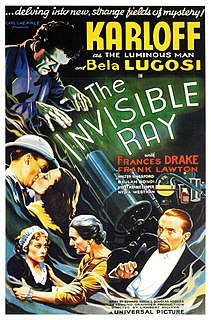
The Invisible Ray is a 1936 American science fiction horror film directed by Lambert Hillyer. The film concerns a scientist who creates a telescope-like device that captures light waves from the Andromeda Galaxy, giving him a way to view the distant past. Using this knowledge, he travels to Africa to locate a large, unusual meteorite that fell there a billion years earlier. He discovers that the meteorite is composed of a poisonous unknown element, "Radium X". After exposure to its rays begins to make him glow in the dark, his touch becomes deadly, and he begins to be slowly driven mad.
"Lamb to the Slaughter" (1953) is a short story by Roald Dahl. It was initially rejected, along with four other stories, by The New Yorker, but was published in Harper's Magazine in September 1953. It was adapted for an episode of Alfred Hitchcock Presents that starred Barbara Bel Geddes and Harold J. Stone. Originally broadcast on April 13, 1958, this was one of only 17 AHP episodes directed by Hitchcock. The episode was ranked #59 of the Top 100 Episodes by TV Guide in 2009. The story was adapted for Dahl's British TV series Tales of the Unexpected. Dahl included it in his short story compilation Someone Like You. The narrative element of the housewife killing her husband and letting the policemen partake in eating the evidence was used by Pedro Almodóvar in his 1984 movie What Have I Done to Deserve This?, with a leg of mutton.
"Collision Course" is the thirteenth episode of the first series of Space: 1999. The screenplay was written by Anthony Terpiloff; the director was Ray Austin. The final shooting script is dated 13 August 1974. Live-action filming took place Tuesday 27 August 1974 through Tuesday 10 September 1974.
"Gonna Roll the Bones" is a fantasy short story by American writer Fritz Leiber, in which a character plays craps with Death. First published in Harlan Ellison's Dangerous Visions, it won both the Hugo Award and Nebula Award for Best Novelette.

Night of the Eagle is a 1962 British horror film directed by Sidney Hayers. The script by Charles Beaumont, Richard Matheson and George Baxt was based upon the 1943 Fritz Leiber novel Conjure Wife. The film was retitled Burn, Witch, Burn! for the US release.

"Coming Attraction" is a science fiction short story by American writer Fritz Leiber, originally published in the second issue of Galaxy Science Fiction with illustrations by Paul Callé. The story was nominated for a Retro Hugo Award in 2001.
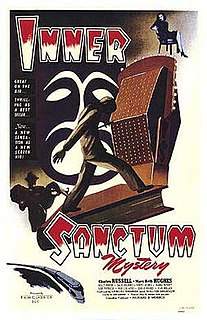
Inner Sanctum is a 1948 American film noir directed by Lew Landers based on the Simon & Schuster book series of the same name and the Inner Sanctum Mystery radio series. A previous film series of the show had been produced by Universal Pictures until 1945. It is the first and only film of M.R.S. productions, the initials of Richard B. Morros, Samuel Rheiner and Walter Shenson.
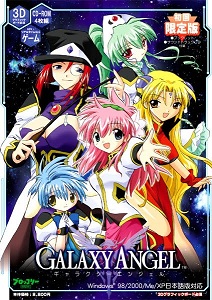
Galaxy Angel is a bishōjo sci-fi metaseries composed of anime, manga and dating sim video games. It was created by Broccoli in July 2000, when it launched a multi-platformed project called Project G.A. The anime and Galaxy Angel Party manga comprise a comedy story in an alternate universe, while the games and the regular manga have a serious romance and action plot.














